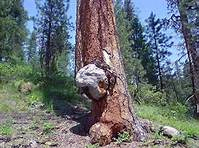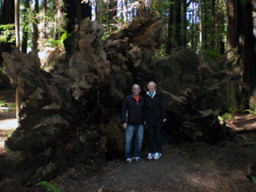On March 16th, my son, husband, and I drove the northern California coast – and the Avenue of the Giants led us through the redwood forests. It is an amazing species living in a miraculous ecosystem. On the way home, I pondered what we might learn about human systems and organizations from these towering trees.
Being a bit geeky, I did some research on what enables the redwoods to flourish, to live to be over 2000 years old and to be the world’s tallest organism. Here is what I uncovered and what I think we might learn from them.
 The Research: You’ll notice funny bulges on these trees, they are called burls. These are another mechanism to reproduce, in addition to the seeds from pine cones. All in all, new redwoods can come from three sources: the seeds of pine cones, the burls, or from sprouts that spring from the parent’s root systems.
The Research: You’ll notice funny bulges on these trees, they are called burls. These are another mechanism to reproduce, in addition to the seeds from pine cones. All in all, new redwoods can come from three sources: the seeds of pine cones, the burls, or from sprouts that spring from the parent’s root systems.
The Lesson: I believe, in general, we’ve lost sight of the need to nurture talent. In the quest to be lean, there is a desire to only have the right amount of talent at exactly the right time. There is no patience for the inefficiency that comes with learning something new. If there is a way to grow people in organizations, it tends to be singular rather than mufti-faceted. We either hire talent in, contract for it, or offer singular learning programs for a select few.
We lose sight of what nature teaches us – that growing the next generation requires time, redundancy (not all will make it), and the more ways we have to produce the next generation, the better.
The Research: These giant trees have a number of mechanisms that protect them from natural dangers. Their bark can be up to 1 foot in depth – affording protection to fire similar to the heat shield on the space shuttles. Their red color comes from a high level of tannin. This serves as a natural pesticide and fungicide as insects are repelled by the tannin.
The Lesson: Redwoods teach us that we need to know our vulnerabilities and find mechanisms to overcome them. For the redwoods, fire and pests can be their undoing, and they have developed a highly effective way that is inherent in their genetic make up to thwart these risks.
Organizations today face many perils – and we see example after example of those that can’t adapt. Blockbuster went from being number one to bankruptcy by failing to attend to the fact that Redbox and Netflix had fundamentally changed the game. Kodak ruled photography and was one of the first to move into digital space, but failed to adapt quickly enough. RIM (Blackberry) is struggling to recapture their market after a thorough trouncing from Apple and Android smart phones.
Rather than insulating themselves, organizations today need to build internal capabilities that enable them to constantly scan externally, to innovate internally and to stay closely attuned to the market and their customers.
 The Research: In spite of their extreme height of up to 379 feet, their root system is relatively shallow. Instead of using depth to create stability, their roots radiate out laterally. As such, the root systems of the entire forest become entwined in one large mesh of roots, providing stability for all.
The Research: In spite of their extreme height of up to 379 feet, their root system is relatively shallow. Instead of using depth to create stability, their roots radiate out laterally. As such, the root systems of the entire forest become entwined in one large mesh of roots, providing stability for all.
The Lesson: It’s always been true that organizations operated in an interdependent community. But with Web 2.0 and increased globalization, never has the need to understand and work within this interdependent community been more necessary. Organizations that leverage the power of that connection can flourish. Those that believe they can be a standalone monolith will likely be toppled. Knowing that community matters – and that community is the world and not just your little corner of the world – is vital today.
There are many lessons to be learned from nature – these are only a few. Do you have any to share?




